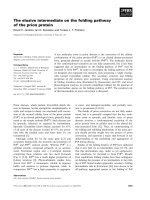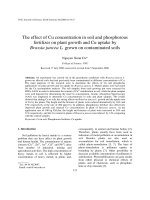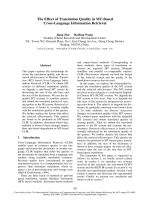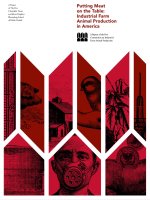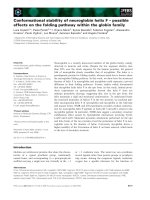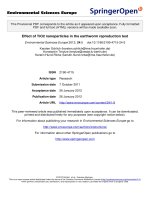3. Effect of cowpea aphid on the biosynthetic pathway of salicylic acid in Glycine max cv. Namdan at reproductive growth stages
Bạn đang xem bản rút gọn của tài liệu. Xem và tải ngay bản đầy đủ của tài liệu tại đây (550.24 KB, 10 trang )
<span class='text_page_counter'>(1)</span><div class='page_container' data-page=1>
<i>Vinh University </i> <i> Journal of Science, Vol. 48, No. 2A (2019), pp. 29-38 </i>
<b>EFFECT OF COWPEA APHID ON THE BIOSYNTHETIC PATHWAY </b>
<b>OF SALICYLIC ACID IN </b><i><b>Glycine max</b></i><b> cv. Namdan </b>
<b> AT REPRODUCTIVE GROWTH STAGES</b>
<b>Tran Ngoc Toan (1), Ngo Thi Lien (2), Nguyen Thi Hoang Anh (2), </b>
<b> Tran Thi Thanh Huyen (3), and Mai Van Chung (1) </b>
<i>1 </i>
<i>Vinh University, Vinh City, Vietnam </i>
<i>2 </i>
<i>Student of K56 Biology, Vinh University, Vinh City, Vietnam </i>
<i>3</i>
<i>Hanoi University of Education, Ha Noi City, Vietnam </i>
Received on 12/3/2019, accepted for publication on 8/5/2019
<b>Abstract: </b> Cowpea aphid (<i>Aphis craccivora</i> Koch) infestation accumulated
phytohormone salicylic acid (SA) in leaves of soybean (<i>Glycine max</i> cv. Namdan) as
these soybean plants were at stages R1 (beginning to bloom) and R3 (beginning pod
development). Activity of major enzymes involving biosynthesis of SA, such as
phenylalanine ammonia-lyase (PAL), benzoic acid 2-hydroxylase (BA2H), was also
enhanced under aphid effect. Changes in activity of these enzymes was closely
correlated with the content of SA in the tissues. The enhancement of the SA
biosynthetic pathway may reduce the effects of <i>A. craccivora</i> on <i>G. max</i> cv. Namdan
plants at reproductive growth stages.
<b>1. Introduction </b>
Salicylic acid (SA) is a phytohormone functioned as an important signal molecule in
plant defense mechanism. SA is mainly known to involve in plant systemic acquired
resistance to pathogens. In a few studies on role of SA in the plant-aphid interaction, an
accumulation of that phytohormone was recorded in barley [3], wheat [8], pea [6] and
soybean [7] as resulted from aphid effects. The enhancement in SA content connects to the
defense mechanisms of antibiosis or aphid repellence in resistant crops [10].
A recent study on the soybean-aphid interaction [12] presented that, cowpea
aphid (<i>Aphis craccivora</i> Koch) is a serious pest of soybean (<i>Glycine max</i> (L.) Merr.) in
the agricultural production in Nghe An Province and SA content was accumulated by
infestation of cowpea aphid and triggered the inducible specific defensive reactions in
leaves of <i>G. max</i> cv. Namdan at vegetative growth stages.
In the present study, we investigated the enhanced generation of SA in <i>G. max</i> cv.
Namdan plants at reproductive growth stages under the effect of the different number of
<i>A. craccivora</i> individuals. Besides, activity of main enzymes in SA biosynthesis such as
phenylalanine ammonia-lyase (PAL) and benzoic acid 2-hydroxylase (BA2H) were
assayed. Finally, changes in content of 4-hydroxybenzoic acid (4HBA)-another
metabolic product from SA-precursor in the SA biosynthesis pathway were also
examined.
</div>
<span class='text_page_counter'>(2)</span><div class='page_container' data-page=2>
<i>T. N. Toan, N. T. Lien, N. T. H. Anh, T. T. T. Huyen, M. V. Chung / Effect of cowpea aphid on the… </i>
<b>2. Materials and methods </b>
<b>2.1. Objectives and experiment </b>
Soybean (<i>Glycine max</i> (L.) Merr. cv. Namdan) plants, whose seeds were
supported by Nghe An Seed Center (Vietnam), were cultured in 15-cm-diameter plastic
pots containing Hoagland medium.
Cowpea aphid (<i>Aphis craccivora</i> Koch) used in the infested experiment was
supported by Department of Applied Entomology (Vietnam Academy of Science and
Technology).
Each soybean plant at stage R1 (beginning bloom) was treated by 10, 20 or 30
wingless adults of <i>A. craccivora</i> that were carefully transferred to soybean leaves with a
fine paintbrush. The control was soybean plants without treatment of aphid. Experiments
were carried out in Plant Physiology Lab (Vinh University).
<b>2.2. The analytical materials </b>
Mature fresh leaves in control and aphid-infested plants were carefully collected
at the R1, R3 (beginning pod development) and R5 (beginning of seed) stage. Leaves
were weighed, immediately frozen in liquid nitrogen for subsequent analyses.
<b>2.3. Methods of analysis </b>
<i><b>a. Measurement of salicylic acid </b></i>
Content of salicylic acid (SA) was determined using HPLC based on method as
described by Yalpani et al [13].
0.5g of frozen soybean leaves were ground in liquid nitrogen into a fine powder,
then extracted twice with methanol 90% then centrifuged at 10,000×<i>g</i> for 15min at 4C.
The selected supernatant was divided into two equal parts and then evaporated to dryness
under a stream of nitrogen. Each part was extracted three times with the extractive
mixture of ethyl acetate:cyclopentane:isopropanol (100:99:1, v/v/v).
After solvent evaporation, the dry residue of the extraction was dissolved in
mobile phase (0.2M acetate buffer, pH 5.0 and 0.5mM EDTA) and analysed by a HPLC
coupling with fluorometric detection. Chromatographic separation was on a Waters
Spherisorb ODS2 column (3μm, 4.6×10mm). Fluorescence spectra were 295nm for
excitation and 405nm for emission. Content of SA was expressed as nanograms per gram
of fresh weight material (ng·g-1 FW).
<i><b>b. Measurement of 4-hydroxybenzoic acid </b></i>
</div>
<span class='text_page_counter'>(3)</span><div class='page_container' data-page=3>
<i>Vinh University </i> <i> Journal of Science, Vol. 48, No. 2A (2019), pp. 29-38 </i>
<i><b>c. Assay of phenylalanine ammonia-lyase </b></i>
Phenylalanine ammonia-lyase (PAL, EC 4.3.1.24) activity was determined by
using the spectrophotometric method [2].
0.5g of frozen leaves was homogenized at 4C in 4mL of 100mM Tris-HCl buffer
(pH 8.9), 5mM -mercaptoethanol and 0.050g PVP. The homogenate was centrifuged at
10,000×<i>g</i> for 25min at 4C to get the supernatant used for enzyme analysis. A volume of
1.5mL of the reaction mixtures contained extract, borate buffer 20mM, pH 8.9 and <i>L</i>
-phenylalanine 10mM. Blank was sample without <i>L</i>-phenylalanine. After incubation at
30C for 24h, the substrate was added and the reaction was stopped with 1.5mL of 2N
HCl. Activity of PAL was measured by the change of absorbance at 290nm using the
UV-Vis CARY 60 spectrophotometer (Agilent, USA), and expressed as micro mole
<i>trans</i>-cinnamic acid per milligram protein per hour (mol <i>trans</i>-cinnamic acid·mg
-1
protein·h-1).
<i><b>d. Assay of benzoic acid 2-hydroxylase </b></i>
Benzoic acid 2-hydroxylase (BA2H) was measured by using HPLC based on
method as described by León et al (1995) [5].
0.5 g of frozen leaves was ground and suspended in 2mL of extractive buffer
[20mM HEPES, pH 7.0, 12.5mM 2-mercaptoethanol, 10mM sorbitol, 1% PVP, and
0.1mM PMSF]. The suspension was vortexed and then centrifuged at 10,000×<i>g</i> for
20min at 4C. The supernatant was used for enzyme assays. In a final volume of 0.5 mL
the reaction mixture contained of 20mM of HEPES buffer (pH 7.0), 1M of BA, 1M of
NAD(P)H, extractive buffer and enzyme extract in equal volume. The BA2H reaction
mixture was incubated in the water bath for 30min at 30C. After centrifuging at
10,000×<i>g</i> for 15min, the supernatant was partitioned triple with 0.50mL of the extractive
mixture of ethyl acetate:cyclopentane:isopropanol (100:99:1, v/v/v). The extract was
transferred to a 2mL glass and evaporated to dryness under a stream of nitrogen. The
sample was dissolved in 250mL mobile phase, thoroughly mixed, then transferred to
Eppendorf tubes and centrifuged at 15,000×<i>g</i> for 2min. A volume of 200mL of extract
was collected and placed in a glass vial fitted with a rubberized Teflon-sept and the
contribution of PP and placed in the chamber of auto sampler. Activity of BA2H was
expressed as nanograms of SA obtained as a reaction product extracted from one
milligram of protein during one hour (ng SA.h-1·mg-1 protein).
In all the enzyme analyses, protein content was determined following the method
of Bradford (1976) using bovine serum albumin (Sigma-Aldrich) as a standard [1].
<i><b>e. Statistical analysis </b></i>
</div>
<span class='text_page_counter'>(4)</span><div class='page_container' data-page=4>
<i>T. N. Toan, N. T. Lien, N. T. H. Anh, T. T. T. Huyen, M. V. Chung / Effect of cowpea aphid on the… </i>
<b>3. Results </b>
<b>3.1. Accumulation of salicylic acid in leaves of </b><i><b>Glycine max</b></i><b> cv. Namdan </b>
<b>under effect of </b><i><b>Aphis craccivora </b></i>
<b>Fig. 1: </b><i>Effect of Aphis craccivora on SA content in leaves of Glycine max cv. Namdan. </i>
<i>Values are means ± SE of three independent experiments</i>
Under the effect of 20 and 30 aphid individuals SA was remarkably accumulated
at the R1 stage and then strongly reduced at R3 and R5, whereas this phytohormone in
10-aphid infested plants was lately induced to peak at R3 and maintained high level till
R5 (Fig. 1). The highest content of SA obtained as 106.39ng·g-1 FW in 30-aphids
infested leaves at R1, by 3.24-fold higher than that in the beginning of experiment
(32.82ng·g-1 FW) and 2.61-fold higher than in the control plants (40.92ng·g-1 FW). The
relation between the accumulated content of SA and aphid density was only recorded at
R1.
Content of SA in the control plants maintained consistently at lower levels. The
significant differences between concentration of SA in aphid-infested leaves and control
were recorded in all points of investigated time.
<b>3.2. Change in activity of SA biosynthetic enzymes in leaves of </b><i><b>Glycine max</b></i>
<b>cv. Namdan under effect of </b><i><b>Aphis craccivora </b></i>
<i><b>a. Activity of PAL </b></i>
</div>
<span class='text_page_counter'>(5)</span><div class='page_container' data-page=5>
<i>Vinh University </i> <i> Journal of Science, Vol. 48, No. 2A (2019), pp. 29-38 </i>
There was a higher level of PAL activity in <i>G. max</i> cv. Namdan leaves infested
by <i>A. craccivora</i> than that in the control at the R1 and R3 stages (Fig. 2). Activity of
PAL in aphid-infested leaves strongly increased and reached to maximum level at stage
R1, at which enzyme in 20- and 30-aphid infested leaves exposed to be greatly enhanced.
The highest values (6.99mol <i>trans</i>-cinnamic acid·mg-1protein·h-1) was recorded in
20-aphid infested leaves, by 2.43-fold and 4.85-fold higher than that in the control and
before aphid treating, respectively. After reaching to peak, activity of PAL strongly
reduced between R3 and R5 stages. In the control, this enzyme remained lower activity
and little changed throughout the experiment.
<i><b>b. Activity of BA2H </b></i>
<b>Fig. 3: </b><i>Effect of Aphis craccivora on BA2H activity in leaves of Glycine max cv. </i>
<i>Namdan. Values are means ± SE of three independent experiments</i>
</div>
<span class='text_page_counter'>(6)</span><div class='page_container' data-page=6>
<i>T. N. Toan, N. T. Lien, N. T. H. Anh, T. T. T. Huyen, M. V. Chung / Effect of cowpea aphid on the… </i>
<b>3.3. Change in content of 4-hydroxylase benzoic acid in leaves of </b><i><b>Glycine max</b></i>
<b>cv. Namdan under infestation of </b><i><b>Aphis craccivora </b></i>
<b>Fig. 4: </b><i>Effect of Aphis craccivora on 4HBA content in leaves of Glycine max cv. Namdan. </i>
<i>Values are means ± SE of three independent experiments</i>
In leaves of soybean infested by cowpea aphid, content of 4HBA tended to
increase continuously from the R1 to R5 stage and was mostly higher than that in the
control plants (Fig. 4). The strongest increase was recorded in the 20- and 30-aphid
infested soybean plants. The highest content of 4HBA was 292.51ng·g-1 FW, which was
2.09-fold higher than that as compared to what observed at beginning of the experiment
(139.81ng·g-1 FW) and 2.21-fold higher than in the control plants (131.79ng·g-1 FW).
Accumulation of 4HBA was proportional with infestation’s intensity from different
numbers of cowpea aphid at the R1 and R3 stages.
<b>4. Discussion </b>
</div>
<span class='text_page_counter'>(7)</span><div class='page_container' data-page=7>
<i>Vinh University </i> <i> Journal of Science, Vol. 48, No. 2A (2019), pp. 29-38 </i>
<b>Fig. 5: </b><i>The phenylalanine pathway</i> [11]
Our study recorded that generation of SA was strongly decreased (Fig. 1) whereas
4HBA content tended to increase continuously from the R1 to R5 stage (Fig. 4). It is
possible that <i>trans</i>-cinnamic acid mainly converted to SA in one branch of pathway at
R1; whereas, at R3 and R5, metabolism of this unsaturated carboxylic acid was strongly
turned to 4HBA in another branch.
</div>
<span class='text_page_counter'>(8)</span><div class='page_container' data-page=8>
<i>T. N. Toan, N. T. Lien, N. T. H. Anh, T. T. T. Huyen, M. V. Chung / Effect of cowpea aphid on the… </i>
aphids early invoked SA-defensive genes, the strong accumulation of SA may be a
critical step in the signaling of downstream responses of plants to aphids.
PAL, the first enzyme in the SA biosynthesis pathway, was strongly induced in
<i>G. max</i> leaves after <i>A. craccivora</i> infestation (Fig. 2). A proportional relation between
PAL activity and SA content recorded in the aphid-infested leaves of <i>G. max</i> cv. Namdan
indicated that PAL induction is closely associated with SA accumulation in the
SA-related signaling pathway induced upon aphid infestation. Similar results were previously
found in other crops following aphid attack [4], [9], [14]. An increase in PAL activity
was strictly connected to biosynthesis of SA, flavonoids and other antioxidants. Those
compounds with deterrent, toxic and anti-nutritional properties were among the aphid
repellents that may prevent aphids from infestation or settling on host plants.
Enzyme BA2H, whose major biochemical function is catalyzing the conversion
of benzoic acid to SA, has related to the plant SA signaling. Early studies mainly
reported function of BA2H in plants defense against pathogens [5], [13]. Limited
information has mentioned an involvement of BA2H in plant response to herbivores.
Previous studies presented that an accumulation of BA2H in <i>Pisum sativum</i> seedlings
after pea aphid infestation [6] or in defense response of G. <i>max</i> cv. Namdan to cowpea
aphid at vegetative growth stages [12]. Similarly, our study confirmed that <i>A. craccivora</i>
resulted in an enhancement of BA2H activity in soybean Namdan at reproductive growth
stages (Fig. 3). Furthermore, the inducible change in activity of BA2H was closely
correlated with the alteration of the SA level (Fig. 1). Therefore, we suggested that
enzyme BA2H probably participated in the SA-related signaling defense mechanism of
soybean Namdan.
<b>5. Conclusion </b>
The SA-related signaling pathway is involved in the defense response of <i>G. max</i>
cv. Namdan to <i>A. craccivora </i>at reproductive growth stages. Under effect of cowpea
aphid, phytohormone SA in soybean Namdan leaves was accumulated to a high level
since the R1 stage. Major enzymes in the SA biosynthesis such as PAL and BA2H were
also elicited by the aphid; the change in activity of these enzymes was closely correlated
with the induced content of SA. The accumulation of the SA signaling pathway may
contribute to protect soybean Namdan plants from damage caused by cowpea aphid
infestation.
<b>Acknowledgements </b>
The authors would like to thank Prof. I. Morkunas (Poznan University of Life
Sciences) and her reseach group for the possibility to conduct analyses under HPLC
system.
<b>REFERENCES </b>
</div>
<span class='text_page_counter'>(9)</span><div class='page_container' data-page=9>
<i>Vinh University </i> <i> Journal of Science, Vol. 48, No. 2A (2019), pp. 29-38 </i>
[2] Cahill D. M. and J. A. McComb, “A comparison of changes in phenylalanine
ammonia-lyase activity. Lignin and phenolic synthesis in the roots of <i>Eucalyptus </i>
<i>callophylla </i> (field resistant) and <i>E. marginata</i> (susceptible) when infected with
<i>Phytophtora cinnamoni,</i>” <i>Physiol. Mol. Plant Path.,</i> Vol. 40, pp. 315-332, 1992.
[3] Chaman M. E., S. V. Copaja and V. H. Argandona, “Relationships between salicylic
acid content, phenylalanine ammonia-lyase (PAL) activity, and resistance of barley to
aphid infestation,” <i>J. Agric. Food Chem.,</i> Vol. 51, pp. 2227-2231, 2003.
[4] Gao L. L., J. P. Anderson, J. P. Klingler, R. M. Nair, O. R. Edwards and K. B. Singh,
“Involvement of the octadecanoid pathway in bluegreen aphid resistance in <i>Medicago </i>
<i>truncatula,</i>” <i>MPMI</i>, Vol. 20, pp. 82-93, 2007.
[5] León J., V. Shulaev, N. Yalpani, M. A. Lawton and I. Raskin, “Benzoic acid
2-hydroxylase, a soluble oxygenase from tobacco, catalyzes salicylic acid biosynthesis,”
<i>Proc. Natl. Acad. Sci.,</i> USA, Vol. 92, 1995, pp. 10413-10417.
[6] Mai V. C., K. Drzewiecka, H. Jeleń, D. Narożna, R. Rucińska-Sobkowiak, J. Kęsy, J.
Floryszak-Wieczorek, B. Gabryś and I. Morkunas, “Differential induction of <i>Pisum </i>
<i>sativum</i> defense signaling molecules in response to pea aphid infestation,”<i> Plant Sci</i>.,
Vol. 221-222, pp. 1-12, 2014.
[7] Mai V. C., N. T. Tran and D. S. Nguyen, “The involvement of peroxidases in soybean
seedlings’ defense against infestation of cowpea aphid,” <i>Arthropod-Plant Interact.,</i> Vol.
10, pp 283-292, 2016.
[8] Mohase L. and A. van der Westhuizen, “Salicylic acid is involved in resistance
responses in the Russian wheat aphid-wheat interaction,”<i> J. Plant Physiol.</i>, Vol. 159, pp.
585-590, 2002.
[9] Moran P. J. and G. A. Thompson, “Molecular responses to aphid feeding in
<i>Arabidopsis </i>in relation to plant defense pathways,” <i>Plant Physiol</i>., Vol. 125, pp.
1074-1085, 2001.
[10] Morkunas I., V. C. Mai and B. Gabryś,“Phytohormonal signaling in plant responses
to aphid feeding,” <i>Acta Physiol. Plant</i>., Vol. 33, pp 2057-2073, 2011.
[11] Smith-Becker J., E. Marois, E. J. Huguet, S. L. Midland, J. J. Sims and N. T. Keen,
“Accumulation of salicylic acid and 4-hydroxybenzoic acid in phloem fluids of
cucumber during systemic acquired resistance is preceded by a transient increase in
phenylalanine ammonia-lyase activity in petioles and stems,” <i>Plant Physiol</i>., Vol. 116,
pp. 231-238, 1998.
[12] Tran N. T., T. T. H. Tran, N. D. Do and V. C. Mai, “The accumulation of SA- and
JA-signaling pathways in response of <i>Glycine max cv.</i> “Nam Dan” to infestation of <i>Aphis </i>
<i>craccivora,</i>” <i>J. Plant Protect. Res</i>., Vol. 57, pp. 321-330, 2017.
</div>
<span class='text_page_counter'>(10)</span><div class='page_container' data-page=10>
<i>T. N. Toan, N. T. Lien, N. T. H. Anh, T. T. T. Huyen, M. V. Chung / Effect of cowpea aphid on the… </i>
[14] Zhu-Salzman K., R. A. Salmon, J.-E. Ahn and H. Koiwa, “Transcriptional
regulation of sorghum defense determinants against a phloem-feeding aphid,” <i>Plant </i>
<i>Physiol.</i>, Vol. 134, pp. 420-431, 2004.
<b>TÓM TẮT </b>
<b>TÁC ĐỘNG CỦA RỆP HẠI ĐẾN SINH TỔNG HỢP </b>
<b>AXIT SALICYLIC TRONG CÂY ĐẬU TƯƠNG NAM ĐÀN </b>
<b>Ở GIAI ĐOẠN RA HOA KẾT QUẢ </b>
</div>
<!--links-->

